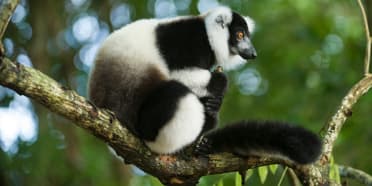
Safari Tours to Palmarium Reserve
-
![18-Day Best of Madagascar's Forests, Beaches and Wildlife]()
18-Day Best of Madagascar's Forests, Beaches and Wildlife
$3,022 pp (USD)
Madagascar: Shared tour (max 60 people per vehicle)
Mid-range Lodge & HotelYou Visit: Antananarivo (Start), Antsirabe (City), Morondava (Town), Kirindy Forest, Bekopaka (Town), Bemaraha NP, Andasibe-Mantadia NP, Analamazaotra NP, Palmarium Reserve, Mahambo (Town), Nosy Boraha, Ivato Airport (Antananarivo), Antananarivo (End)

Soul Of Madagascar Tours
4.9/5 – 35 Reviews
-
![10-Day Madagascar Rainforest and Island Odyssey]()
10-Day Madagascar Rainforest and Island Odyssey
$1,958 pp (USD)
Madagascar: Shared tour (max 8 people per vehicle)
Mid-range Lodge & HotelYou Visit: Antananarivo (Start), Andasibe-Mantadia NP, Palmarium Reserve, Mahambo (Town), Nosy Boraha, Antananarivo (End)

Madagascar Natural Tours
5.0/5 – 7 Reviews
-
![14-Day The Pristine Forests of Madagascar]()
14-Day The Pristine Forests of Madagascar
$2,428 pp (USD)
Madagascar: Private tour
Mid-range Camping & LodgeYou Visit: Antananarivo (Start), Ankafobe Reserve, Antsirabe (City), Ranomafana NP, Ambositra (City), Palmarium Reserve, Andasibe-Mantadia NP, Antananarivo (End)

Malagasya Travel
4.8/5 – 15 Reviews

 Madagascar Parks
Madagascar Parks






